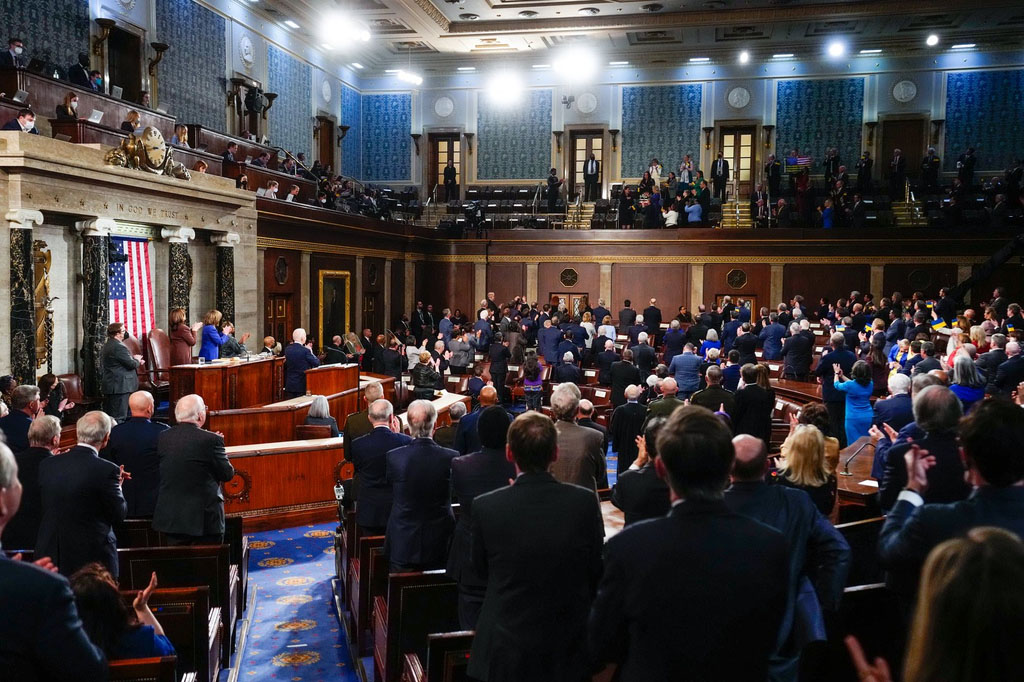
The Courts have acquiesced, the populace is compliant and the Democratic Party is splintered. Without any way to make their opposition felt, Trump’s opponents’ only hope is that the economy will cause MAGA voters to rethink.
Amidst bipartisan solidarity with Ukraine, Joe Biden’s State of the Union address focused on unity and reconciliation. But in reality, deep rifts remain not just between the parties, but within them too. The jockeying for 2024 has already long begun.
The seriousness of the Russian invasion of Ukraine is just starting to dawn on Americans. But it gave President Biden in his first State of the Union speech on March 1 an opportunity to unite Republicans and Democrats in a rare display of solidarity, and to downplay the difficulties of his first year in office.
In the House Chamber, sympathy for the Ukrainian people was everywhere. The Ukrainian ambassador sat next to the First Lady and was hugged and applauded as she waved a tiny Ukrainian flag. Women were dressed in blue-and-yellow ensembles, men wore blue-and-yellow lapel pins, and they rose together in standing ovations as the president talked about the conflict between democracy and autocracy.
His declaration that the US would ban Russian planes from its air space got the most applause. Yet the most unifying parts of Biden’s speech may not actually have been his sabre-rattling pronouncements but the conciliatory gestures he made toward Republicans and moderate Democrats: his call to support the police and nurture economic competition, his pledge not to raise taxes for incomes below $400,000, his sunny assertion that he was a capitalist after all. For the first time since taking office, he acted more like the soft-spoken, deal-making senator that he’d been for 36 years than the radical president who’d proposed sweeping but unrealistic plans.
The fact is that Biden had a terrible first year in office. If anyone’s memory needs refreshing, it began on 6 January 2021, weeks before his inauguration, with an attempt to storm the Capitol by a mob inspired by an ex-president who wouldn’t admit that he’d lost the election. After trying to calm the nerves of a shocked country, Biden had to navigate a second wave of Covid that killed some 447,000 Americans, 100,000 more than in the previous year. Though he managed to get two major pieces of legislation through Congress, and though most of the economic indicators were positive, the prevailing mood during his first year in office was bitter, sullen, devoid of hope.

US President Joe Biden at the State of the Union in 2022 Photo by The White House, Public domain, via Wikimedia Commons
This was understandable on the Trump right, which stayed fiercely loyal to the ex-president, even censuring Republicans who’d spoken up against him. But anger and despair pervaded the Democratic side, too. Pundits on the left continued auguring the death of democracy, wincing every time Trump held a rally. On CNN or CNBC, it sounded like Trump had already won the 2024 election. Whether the country was recovering from Trump or Covid, the convalescence felt interminable.
Economically, Biden had a mixed record. Unemployment was under 4%, and there were more jobs than people to fill them – though many were in the underpaid service sector. There were lingering supply chain problems that weren’t Biden’s fault. The big concern was inflation, which in the first months of 2022 went up to 7.5%, the highest rate in forty years. In his SOTU speech, the president proposed lowering drug costs and buying American products. But these were only vague and partial solutions. It was clear that inflation was the elephant in the room. It will continue to haunt the Democrats in the midterm elections.
In 2021, Biden scored points in other areas. He reinstated many of the environmental regulations that Trump had rolled back. He squeaked through Congress a Covid relief bill ($2 trillion) and the first major infrastructure bill ($1 trillion) in more than a decade. In two highly publicized trials, the killers of George Floyd and Ahmaud Arbury were sentenced to life imprisonment. The outrage generated by the Black Lives Matter movement was finally having its effect, and a good deal of public sentiment appeared to be directed toward righting the wrongs of America’s systemic racism.
So, apart from Covid, why were Americans so grim? Why were Biden’s ratings dismal in every area? The latest Washington Post poll gives him 37% approval on the economy, 44% on his handling of Covid, and says that even though there are more registered Democrats than Republicans, a majority prefers that Republicans retake Congress in 2022.
The real story behind Biden’s first year as President lies not so much with his performance as with the political parties, and the machinations of Republican governors and state legislatures to bypass federal laws.
As one TV commentator said recently, ‘It used to be that the parties both wanted to improve the country, though by different means. Now they see each other as mortal enemies.’
That’s putting it mildly. The parties are not only bitter enemies, but split within their ranks. We haven’t seen anything like this since Ross Perot broke from the Republican party in 1992 and crushed George H.W. Bush’s hopes for a second term. Even then, the issues were more about political philosophy than power and careerism.
The Democrats may be in worse shape than the Republicans. They hold a razor-thin majority in both houses, but two senators in their ranks – Joe Manchin of West Virginia and Kyrsten Sinema of Arizona – torpedoed major bills that would have bolstered voting rights for minorities and provided a variety of needed social benefits. Until recently, the progressive wing of the party, led by Alexandria Ocasio-Cortez of New York and Pramila Jayapal of Washington State, has been stubbornly uncompromising, thereby contributing their share to the adversarial climate. Everybody seemed to forget the first lesson of Government 101: in a democracy, nobody gets everything they want.
But the Republicans are deeply split, too. According to the NY Times, the Republican establishment is starting to wake up. With the help of a group of pre-Trump Republicans like senators Lisa Murkowsky (Alaska) and Susan Collins (Maine), senator minority leader Mitch McConnell (Kentucky) has been working feverishly behind the scenes to replace Trump-supported candidates in the mid-term primaries. But nothing is certain. ‘Mr. McConnell’s hard sell’, writes NYT reporter Jonathan Martin with delicate understatement, ‘is so far yielding mixed results’.
Disturbingly, a number of rightwing representatives and senators are acting more like Trump than Trump himself. Representative Marjorie Taylor Greene (Georgia) and Senator Josh Hawley (Missouri) may not be familiar names in Europe, but along with Senators like Ted Cruz (Texas) and Tom Cotton (Arkansas), they form a righter-than-right group poised to step into Trump’s shoes should he prove too out-of-step with the rest of the party in 2024.
The most alarming developments in 2021 were on a state level. Twenty-three legislatures are controlled by local Republican parties versus fourteen controlled by the Democrats, and they made full use of their advantage. Some of their most insidious efforts were focused on gerrymandering and interfering in citizens’ voting rights. According to the Brennan Center for Justice, in 2021 nineteen states passed thirty-four laws restricting voting, while an astounding 440 bills with voting restrictions in them were introduced in 49 state legislatures. Texas was particularly notorious. Its SB1 bill limited voting by mail, reduced voting hours, and prohibited assistance for disabled voters – measures that seemed the product of warped imaginations.
The other area of interest to state legislatures was abortion. In 2021, 108 restrictions were passed in nineteen states, the most since Roe vs. Wade in 1973. Again, Texas went furthest, making it effectively impossible to have an abortion after six weeks of pregnancy, increasing the driving distance to abortion clinics to over 200 miles, and making it possible for individuals to sue neighbours who participate in any aspect of the abortion process.
To say nothing of the fact that in its coming term, the heavily conservative US Supreme Court is poised to reverse the entire Roe vs. Wade decision. Trump and his minions may have lost the battle of 2020, but all indications are that on a day-to-day basis, they’re far from losing the war.
Two final observations about the difficult first year of the Biden Presidency, and the even more difficult one to follow:
While Biden’s grandfatherly demeanour helped to calm the waters of a heated Democratic primary in 2020, it has served him poorly as president. More than his actions, his style may be his biggest problem. Few have confidence in his ability to lead. Politicians and pundits on both left and right regard him as ‘weak’. There are whispers that he’s… losing it. Trump might have repelled a lot of people, but his swagger struck a major chord in the American psyche. In this era of Tiktok and Tweets, Biden’s halting manner feels tragically out of date.
Then there’s Donald Trump. Even though social media ostracized him, his meme is still front and centre. Reports are that he’s raised over $22m for his comeback campaign in 2024. For his Republican core, he remains the Great White Hope; for the Democrats, the Devil Incarnate. These images are so engrained in the minds of Americans that it doesn’t matter what he actually says and does.
Which is fortunate for him, because lately he’s been saying odd things. He stands by his effusive praise of Putin and insists that the Ukraine War would never have happened had he been president. Unlike his supporters, he’s changed his position on vaccines, and now brags about the effectiveness of the booster shot. And though advisers urge him to discard the rigged-election trope and address Biden’s policies, he still harps incessantly on how the 2020 election was stolen from him.
Trump is under attack from several courts and investigating committees. In New York state, two separate cases allege that his company aided their executives to avoid paying taxes and overestimated their assets to impress potential investors. In Georgia, he’s accused of criminally interfering in the 2020 election. In Washington DC, a case is pending against him for overpaying his family business – owner of the Trump International Hotel – with federal funds to rent space for the 2017 inaugural. His long-time accounting firm has dropped him, saying they can no longer stand behind the figures he provided to the Internal Revenue Service.
To say nothing of January 6. On 3 March 2022, a house committee filed a court brief saying that ‘the president and his campaign engaged in a criminal conspiracy to defraud the United States’. If the case proceeds, Trump will be prosecuted by the Justice Department of the same executive that he led for four years.
Will any of this stop him? Can a man as ill-equipped to govern as Donald Trump really make a comeback and retake the presidency? If we still lived in what used to be called ‘reality’, the answer would be clear. But now that many Americans are locked into media universes full of conspiracy fantasies and their own projections, one has to wonder. Will the threat of World War make them aware that they live in a world growing smaller every day?
Stay tuned.
Published 10 March 2022
Original in English
First published by Eurozine
© George Blecher / Eurozine
PDF/PRINTSubscribe to know what’s worth thinking about.

The Courts have acquiesced, the populace is compliant and the Democratic Party is splintered. Without any way to make their opposition felt, Trump’s opponents’ only hope is that the economy will cause MAGA voters to rethink.

Four months into Trump’s second term and the president’s ICE raids on immigrants, triggering protests in Los Angeles now under troop surveillance, prove that ‘democracy is under assault’. Could a historic courtroom reprimand provide the necessary guidance for a moral reset?